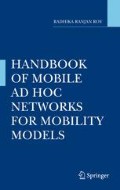Abstract
The stochastic properties of the random waypoint mobility model that has been used widely in analysis and simulation of mobile ad hoc networks are described. The limitations of the RWP and mitigations of those limitations are explained. Many variations of the RWP model are described. We have derived the analytical model of the RWP with arbitrary waypoints and have proved that the random waypoint at the boundary is a special case of this.
Access this chapter
Tax calculation will be finalised at checkout
Purchases are for personal use only
References
Bettstetter, C et al (2003) Stochastic Properties of the Random Waypoint Mobility Model. Kluwer Academic Publishers
Camp, T et al (2002) A Survey of Mobility Models for Ad Hoc Network research. WCMC
Hossmann, T (2006) “Mobility Prediction in MANETs. Master’s Thesis, Swiss Federal Institute of Technology, Zurich
Bettstetter, C, Hartenstein H, and Perez-Costa, X (2002) Stochastic Properties of the Random Waypoint Mobility Model: Epoch Length, Direction Distribution, and Cell Change Rate. MSWiM’02/ACM, September 2002
Bettstetter, C et al (2003) The node distribution of the random waypoint mobility model for wireless ad hoc networks. IEEE Transaction on Mobile Computing
Resta, G and Santi, P (2002) An Analysis of the Node Spatial Distribution of the Random Waypoint Model for Ad Hoc Networks. MSWiM
Ghosh, B (1951) Random distances within a rectangle and between two rectangles. Bulletin of the Calcutta Mathematical Society 43:17–24
Papoulis, A (1991) Probability, Random Variables, and Stochastic Process. McGraw-Hill, New York
McGuire, M (2005) Stationary Distributions of Random Walk Mobility Models for Wireless Ad Hoc Networks. MobiHoc
Bai, F et al (2003) IMPORTANT: A Framework to Systematically Analyze the Impact of Mobility on Performance of Routing Protocols for Ad Hoc Networks. INFOCOM
Bettstetter, C (2001) Smooth is Better than Sharp: A Random Mobility Model for Simulation of Wireless Networks. MSWiM
Yoon, J et al (2003) Random Waypoint Considered Harmful. INFOCOM
Yoon, J et al (2003) Sound Mobility Models. MobiCom
Boudec, J L and Vojnovic, M (2005) Perfect Simulation and Stationary of a Class of Mobility Models. INFOCOM
Jamalipour, A (2003) The Wireless Mobile Internet: Architectures, Protocols and Services. John Wiley & Sons, New Jersey
Blazevic, L et al (2004) A location based routing method for mobile ad hoc networks. IEEE Transactions on Mobile Computing 3(4)
Jardosh, A et al (2005) Real-word environment models for mobile network evolution. IEEE Journal on Selected Areas in Communications 23(3)
Hsu, W et al (2004) Weighted Waypoint Mobility Model and its Impact on Ad Hoc Networks. MobiCom
Hyytia, E et al (2006) Spatial node distribution of the random waypoint mobility model with applications. IEEE Transaction on Mobile Computing
Weisstein, EW. Disk line picking,” From MathWorld – A Wolfram Web Resource.
Bettstetter, C and Wagner, C (2002) The Spatial Node Distribution of the Random Waypoint Mobility Model. WMAN
Lassila, P et al (2005) Connectivity Properties of Random Waypoint Mobility Model for Ad Hoc Networks. Med-Hoc-Net 2005
Penrose, M D (1998) Extremes for the minimal spanning tree on normally distributed points. Advances in Applied Probability 30(3)
Pham, P P and Perrau, S (2003) Performance Analysis of Reactive Shortest Path and Multi-Path Routing Mechanism with Load Balance. INFOCOM
Ganjali, Y and Keshavarzian, A (2004) Performance Analysis of Reactive Shortest Path and Multi-Path Routing Mechanism with Load Balance. INFOCOM.
Hyytia, E et al (2005) Traffic Load in Dense Wireless Multihop Network. PE-WASUN
Author information
Authors and Affiliations
Corresponding author
Rights and permissions
Copyright information
© 2011 Springer Science+Business Media, LLC
About this chapter
Cite this chapter
Roy, R.R. (2011). Random Waypoint Mobility. In: Handbook of Mobile Ad Hoc Networks for Mobility Models. Springer, Boston, MA. https://doi.org/10.1007/978-1-4419-6050-4_4
Download citation
DOI: https://doi.org/10.1007/978-1-4419-6050-4_4
Published:
Publisher Name: Springer, Boston, MA
Print ISBN: 978-1-4419-6048-1
Online ISBN: 978-1-4419-6050-4
eBook Packages: Computer ScienceComputer Science (R0)

